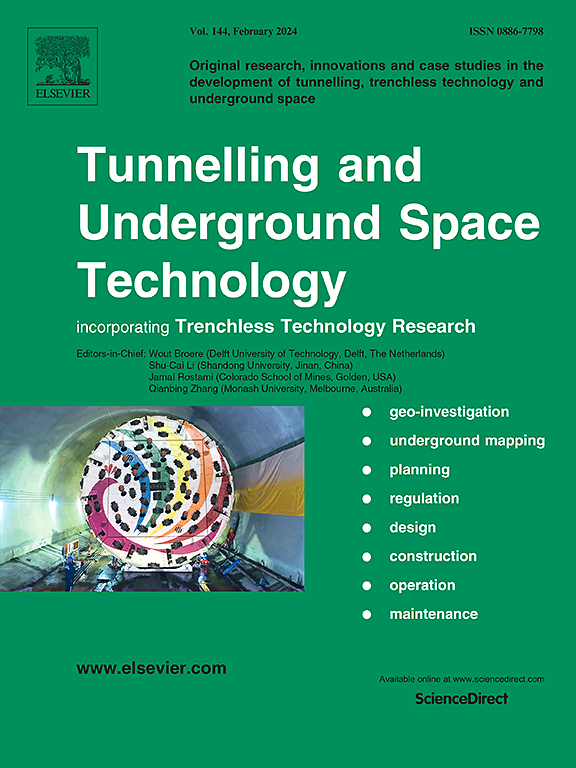考虑地层与隧道参数耦合随机性的盾构隧道下穿铁路桥梁安全性评价
IF 7.4
1区 工程技术
Q1 CONSTRUCTION & BUILDING TECHNOLOGY
引用次数: 0
摘要
在既有铁路桥梁下盾构隧道施工中,地层的非均质性和隧道参数的不确定性往往给铁路运营安全带来重大风险。以实际工程中地质钻探和盾构隧道参数统计数据为基础,结合无条件随机场理论、协同克里格理论和随机函数方法,建立了概率安全评价框架。该方法考虑了地质勘探资料的空间分布约束和掘进参数的统计特征,模拟了地层物理力学性质与掘进过程参数的耦合随机效应。数值结果表明,与只考虑地层或隧道参数随机性的模拟相比,同时考虑地层信息和隧道参数随机性的模拟表现出更大的变异性,强调了它们耦合随机效应的重要性。此外,该方法还对铁路桥梁在不同控制值下的变形超出极限概率进行了评估。对于案例研究,在左线隧道中不需要限速。然而,对于右线隧道,当盾构头到达铁路桥下方时,速度限制为80公里/小时,当盾构头远离桥梁时,速度限制为45公里/小时。最关键的阶段发生在右线隧道中盾构尾从桥下退出时。本文章由计算机程序翻译,如有差异,请以英文原文为准。
Safety assessment of shield tunnel underpassing railway bridges considering coupled randomness of stratigraphy and tunneling parameters
During shield tunneling beneath existing railway bridges, the heterogeneity of strata and the uncertainty of tunneling parameters often pose significant risks to railway operation safety. Based on statistical data from geological drilling and shield tunneling parameters in a real engineering project, this study establishes a probabilistic safety assessment framework by integrating unconditional random field theory, Co-Kriging theory, and stochastic function methods. The approach accounts for the spatial distribution constraints of geological exploration data and the statistical characteristics of tunneling parameters to simulate the coupled stochastic effects of stratigraphic physical-mechanical properties and tunneling process parameters. Numerical results reveal that simulations considering both stratigraphic information and tunneling parameter randomness exhibit significantly greater variability compared to those considering only stratigraphic or tunneling parameter randomness, underscoring the importance of their coupled stochastic effects. Furthermore, the proposed method evaluates the probability of exceeding deformation limits under various control values for railway bridges. For the case study, no speed restrictions are required during left-line tunneling. However, for right-line tunneling, a speed limit of 80 km/h is necessary when the shield head reaches beneath the railway bridge, reducing to 45 km/h as the shield moves away from the bridge. The most critical phase occurs when the shield tail exits from beneath the bridge during right-line tunneling.
求助全文
通过发布文献求助,成功后即可免费获取论文全文。
去求助
来源期刊

Tunnelling and Underground Space Technology
工程技术-工程:土木
CiteScore
11.90
自引率
18.80%
发文量
454
审稿时长
10.8 months
期刊介绍:
Tunnelling and Underground Space Technology is an international journal which publishes authoritative articles encompassing the development of innovative uses of underground space and the results of high quality research into improved, more cost-effective techniques for the planning, geo-investigation, design, construction, operation and maintenance of underground and earth-sheltered structures. The journal provides an effective vehicle for the improved worldwide exchange of information on developments in underground technology - and the experience gained from its use - and is strongly committed to publishing papers on the interdisciplinary aspects of creating, planning, and regulating underground space.
 求助内容:
求助内容: 应助结果提醒方式:
应助结果提醒方式:


